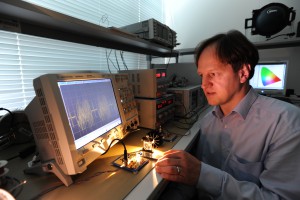26th February 2015 Bangalore, India
Bright idea to transform web access
I had assumed that a simple tiny light emitting diode (LED) can be used only for illumination. But I was zapped when I visited Prof Harald Haas’s lab at the University of Edinburgh last month. I got a glimpse of tomorrow’s future – LEDs transmitting data!
 A LED equipped with signal processing technology was streaming a high-definition video to a computer which was about 20 feet away. Or in simple words a beam of light was not only illuminating the area but also carrying large chunks of data. Prof. Haas and his team also demonstrated that line of sight was not a requirement to send and receive data through light. Light reflected from walls was also carrying data. The implication of these technologies was that wherever there is a light bulb there is also a potential for a wireless Internet connection. In reality, this means that any street lamp could also double up as a web hotspot.
A LED equipped with signal processing technology was streaming a high-definition video to a computer which was about 20 feet away. Or in simple words a beam of light was not only illuminating the area but also carrying large chunks of data. Prof. Haas and his team also demonstrated that line of sight was not a requirement to send and receive data through light. Light reflected from walls was also carrying data. The implication of these technologies was that wherever there is a light bulb there is also a potential for a wireless Internet connection. In reality, this means that any street lamp could also double up as a web hotspot.
But what blew my mind completely was a normal solar panel which could not only generate electricity but also act as a transmitter and receiver of data. The potential of technology is quite enormous. Remote areas including islands which lack power and internet can be lit up and connected to the digital world offering the underprivileged access to information and services.
Wi-fi systems use radio waves to transmit internet data and other information. Likewise, using digital modulation technique called Orthogonal Frequency Divisional Multiplexing (OFDM), LEDs or light bulbs made of LEDs can be made to handle millions of changes in light intensity per second, effectively behaving like an extremely fast on/off switch. This allows large chunks of binary data – a series of ones and zeros – to be transmitted at high speed. Prof Haas has coined the word Light Fidelity (LiFi) for this technique and this is also known as visual light communications. Prof. Haas mentioned that transmission of data via light offers quite a number of advantages in terms of improved security from hackers, transmission of data underwater, use in sensitive areas such as inside aircraft, accident prevention where LED lights from cars can communicate with other cars when they are too close to each other, etc.
With congestion of internet networks a common phenomenon worldwide, LiFi offers a bright light of hope to declog these networks. Prof. Haas has also spun out a company called pureLiFi to commercialise LiFi. Prof. Haas is keen to interact with various research and commercial stakeholders in India and if you are keen to interact with him when he is in India let me know.